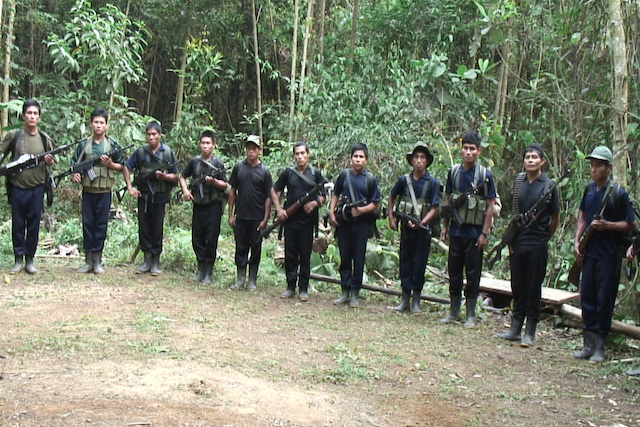
A Shining Path unit ready to go on patrol
This August, newspapers in Peru splashed headlines across their front pages about the huge blow the government had dealt to what is left of the infamous Shining Path—a brutal Maoist guerrilla group that has spent the past 20 years hanging out in the jungle slaughtering peasants and smuggling coke. The headlines announced to the world that Comrade Alipio, the group’s military leader, had been killed.
Alipio’s death was as cartoonish as it was dramatic. A cocaine trafficker who had links to Shining Path, but who’d turned informant for the police, lured an armed column of rebels towards a hut that he owned. Most of the fighters stayed outside, guarding the building while Comrade Alipio and two other Shining Path bigwigs, Comrades Gabriel and Alfonso, went into what was meant to be a safe house, expecting to meet some ladies of the night, all organized by the drug trafficker.
Videos by VICE
Crucially, what Alipio and company didn’t know was that the army had rigged the house with ANFO explosives. As soon as the three rebels had made themselves comfortable, the whole hut went up in one big blast. The charred bodies had to be identified through DNA tests.
As soon as news of the killing came out, my phone wouldn’t stop ringing: I have the arguable privilege of being the only journalist to have met Comrade Alipio, and the local media were desperate for a soundbite.
Back in September 2010, I received a call on behalf of the leadership of the Shining Path, who had agreed to meet me if I travelled, unaccompanied, to Peru’s Valley of the Apurímac, Ene, and Mantaro rivers, known by the acronym VRAEM. It’s a jungle region that routinely serves as the battleground between armed forces and drug lords. The Shining Path contacted me after I sent them a message while I was reporting in the area, tailing some anti-narcotics police patrols a few months prior.
***
The offer was exciting, yet terrifying. In 1980, the Shining Path took up arms vowing not just to defend the peasantry, but to defeat the country’s rulers and hand it over to a proletariat that for generations had struggled beneath the yoke of a tiny, European-descended elite. However, what characterized the Shining Path from the onset were their bloody tactics. Within a few years they had annihilated thousands of Peruvians—most of their victims being the same peasants they were supposed to be going to war for.
The government’s response was no less brutal. After 20 years of conflict, the death toll neared 70,000. In 1992 the conflict was all but finished, after the police finally captured Abimael Guzman, the messiah-styled and deranged Shining Path leader. What was left of the movement retreated to the heart of the VRAEM, where they kept a low profile for a number of years.
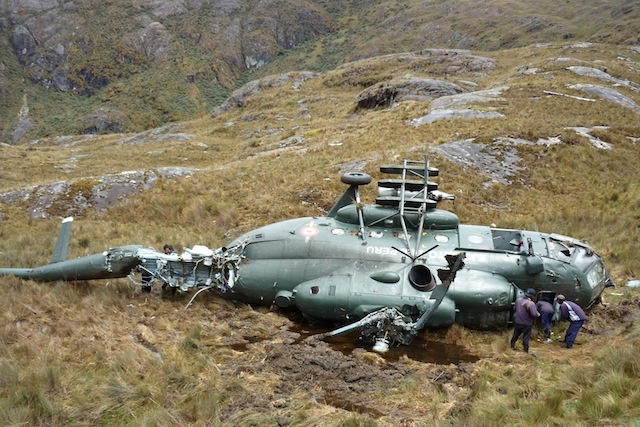
One of the helicopters taken down by the rejuvenated Shining Path in 2010
But, since the mid-2000s, a reinvented version of the group has been stirring up trouble. By 2010, despite their small numbers (they are alleged to have around 300 members in total), they had managed to kill dozens of soldiers and policemen, and even downed three Air Force helicopters.
The Peruvian government blamed its incompetence at fighting the rebels on the inhospitable terrain and, more often than not, on the group’s links with the cocaine drug lords, who are said to back the Shining Path financially. The government spoke of “narcoterrorism,” a phrase that was picked up by mainstream media. The government seemed keen to characterize the enemy they were struggling to defeat as a force big enough to deserve its own sinister metanarrative—that it was some despicable new fusion of commerce and ideology akin to Colombia’s FARC—rather than just 300 peasants living in the countryside.
This alleged involvement in the drug trade prompted the US to step into the conflict and in 2009 Shining Path leader, Comrade Jose (real name Victor Quispe Palomino), was added to the DEA’s list of drug kingpins. The US State Department quickly followed suit and offered a $5 million for the Shining Path’s leader. Could Jose and his followers really be as rich as the drug kingpins from Mexico or Colombia? Could they really be as well-armed as the cocaine-funded Colombian guerrillas, FARC? Something didn’t add up. So I went to find out.
***
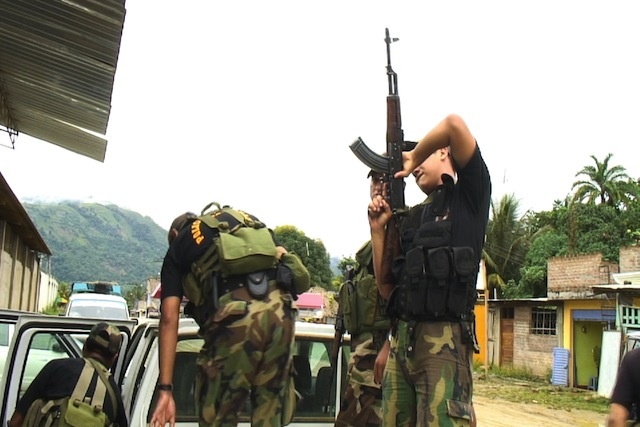
Antinarcotics police on patrol in the VRAEM
After a few bumpy rides across the rugged tracks of the VRAEM, I reached a riverbed, where a boatman came to meet me and, without uttering a single word, sailed me down the river until we reached a tiny settlement. On arrival a wrinkly and chirpy coca farmer greeted me: “So you are the journalist? Come, follow me.”
Four hours later we reached a hut where I was met by four guys armed with automatic rifles. They told me I was their guest and that I should address them as “compañeros” (comrades). I was to spend the night at the shelter, while they waited for further instructions in order to continue the march to meet the Shining Path leadership.
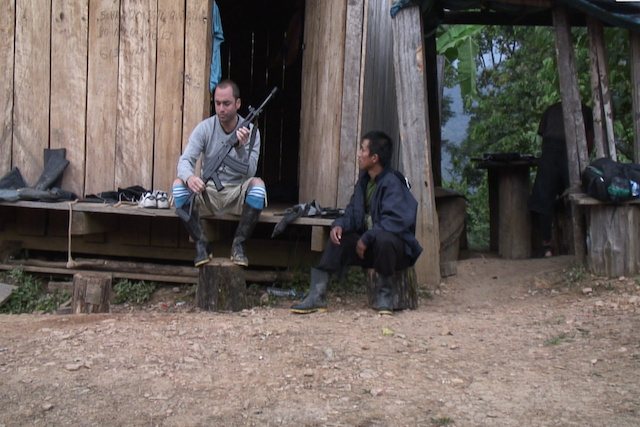
Fernando Lucena, Comrade Alfonso and the captured Galil rifle
The next morning, as we waited for orders to come via walkie-talkie, I chatted with Comrade Alfonso, a rather small guy with a peaceful face, who didn’t fit in with any preconceptions that I had about what a killer ought to look like. I asked Alfonso about his rifle, an Israeli Galil. He told me it had been captured from a soldier they killed at an ambush. Then he nonchalantly passed me the weapon, so that I could have a feel of it.
After a couple more hours of walking, which included hiding in some foliage as an Air Force helicopter passed, we turned a bend and arrived at a clearing in the middle of the jungle, where a column of about 40 armed rebels were standing to greet me. After my initial shock I quickly scanned their faces, hoping to find that of Comrade Jose, the $5 million man. Jose wasn’t there but at the end of the line stood someone I did recognize from newspaper pictures: Comrade Raul, Jose’s brother. It was obvious that the man standing next to him was someone important too, but I couldn’t place him.

The Shining Path’s armed column
I was offered some food. Raul and the other important-looking guy sat with me. It then became clear who this other guy actually was. It was Comrade Alipio, the military leader of the Shining Path, the man behind the most of the armed actions the group carried out in the decade before his death and, at the time, pretty much the most feared man in Peru. Besides a rather outdated picture of him that the newspapers still publish regularly, there were no other images of Alipio in circulation, so it was little wonder I wasn’t able to recognize him from the outset.
Raul started by telling me that this meeting was for us to get to know each other, and that they would grant me the interview at a future opportunity. What followed was an exhausting debate about Marxism, Maoism, and several other isms. Raul displayed very rusty arguments, reminiscent of the Cold War. I guess it’s difficult to keep up to date with politics when you’re holed up in a remote jungle for 20 years.
After we had chatted for a while, Raul told me to get some sleep, though a symphony of jungle noises and a slipped disc in my neck barely let me. The presence of a teenager with a MAG 7.62 heavy machine gun guarding my bedside didn’t help much either.
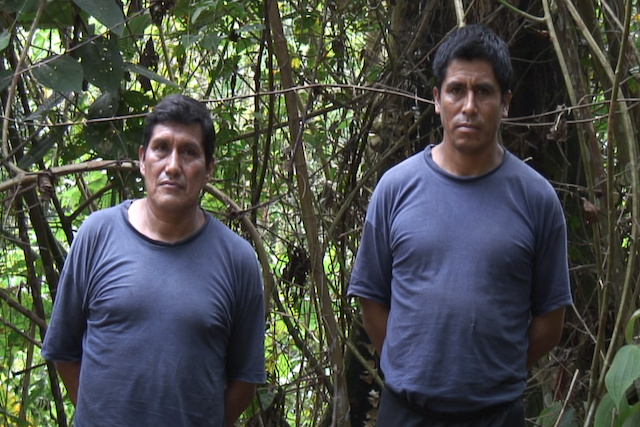
Comrades Raul and Alipio
To my delight, the next morning Raul said we should get on with the interview proper. He told me they had close to no links with the drug lords but that, in the areas under their control, farmers were allowed to cultivate coca. Despite my skepticism, I thought there was some truth to what he said. After all, it was more than clear that they were not a wealthy bunch. I was allowed to look at every weapon they had—they were all labeled “Peruvian Army” or “Peruvian Police.” This ragtag army of men averaging 5’3” in height had actually ambushed the army and police enough times to stock themselves with dozens of automatic rifles.
Raul then went on to make an admission of guilt that the group had never before conceded: “We behaved like criminals; we behaved like terrorists.” He blamed Abimael Guzman, the imprisoned Shining Path founder, for all the barbaric acts they had inflicted on civilians in the past: “We call for the execution of [Abimael Guzman], for the crimes he committed against humanity,” he said. But, despite his current loathing of the psychopathic Guzman and his heinous crimes, Raul and his older brother are known to have participated in several massacres of civilians. I asked him about an infamous one, which took place in the small Andean village of Lucanamarca in 1983. “I participated, and so did Comrade Jose… if we committed excesses in Lucanamarca, if we annihilated children and women, it was because those were the party’s orders.”
Sixty-nine people, including 29 women and children, were slaughtered in Lucanamarca, most of them with machetes, in order to save bullets. How could he justify a people’s movement that routinely killed soldiers, the vast majority of whom came from the impoverished classes?

The children of the Shining Path
“The soldiers are our class brothers, but it’s these enslaving laws that make these sons of the people fight for the State. Why aren’t the sons of the rich serving in the army?” It seemed that Raul had an answer for everything.
Probably the most controversial of the many issues that surround the Shining Path is the presence of several dozen young children within their ranks. “Raul” had proudly given me a USB stick with footage of the Shining Path children shouting Marxist-Maoist slogans they clearly didn’t understand. I questioned him about the origin of these kids, as some reports state that they had been abducted.
“No one will ever prove that we have kidnapped a single child. Our children are not involved in combat, they are the sons and daughters of our combatants and there isn’t a single one of them who cannot read and write.”
Suddenly our interview was cut short by a rebel whispering something in Comrade Raul’s ear. Raul asked me to switch off the camera while whispers between him and Alipio went back and forth. I switched the camera off and then switched it on again. And that’s when the striking question from Raul came: “We’ve just received news that an 80-strong military detachment is heading in our direction, and you have to understand that we want to raise a concern from our part. We wanted to ask if this is because of a plot between you and the enemy?”
Before I could answer, Raul and Alipio began to plan what actions to take. Armed columns of fighters were being sent in different directions. Raul looked as if he had suddenly lost all trust in me, so I tried to make some chitchat with Alipio.
“So, Comrade Alipio, what’s happening?”
“The enemy is on the move, but we’ve got a unit on standby to proceed with an ambush at any moment.”

Shining Path members on patrol through the jungle
Due to what seemed to be an imminent confrontation, Alipio told me to spend a further night at their camp, for my own safety. Fortunately, the next day I learnt that the armed forces’ detachment had headed in a different direction and the Shining Path had called their ambush off.
Just before I was to leave, a shy and inarticulate Comrade Alipio approached me. He coyly told me that he also wanted to say something to the camera. Immediately, I started recording. Unlike Raul, Alipio didn’t have a way with words; his terms were quite simple, bordering on the infantile. He was only interested in talking about one thing. He and his troops had recently attacked an army base, as a result of which three soldiers were killed and a helicopter was downed. To the indignation of Alipio, he and his followers had not received the media exposure they expected after their feat, so he was after some publicity.
After saying goodbye, I was escorted by four rebels on a long walk out of the emergency zone (one of them was actually carrying a loaded RPG launcher). I was then handed over to another coca farmer, with whom I walked through the night. Thirteen hours later, I had been bitten by more types of insects than I knew existed, had poison-ivy rashes all over my arms, two toes infected, and a slipped disk that was hurting like hell, but, finally, I was out of that jungle.
That was back in late 2010. Hundreds of army operatives after that, the forces of law and order still couldn’t get hold of any Shining Path member until August 2013, when Alipio, Gabriel, and Alfonso (the one who lent me his rifle) were lured into a hut and blown to smithereens. That was the end of Alipio: a hardened warrior, murderer and intellectually deficient individual, whose operatives managed to take on the US-backed Peruvian Armed Forces for over a decade.
WATCH – The Huayno Murders



